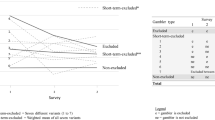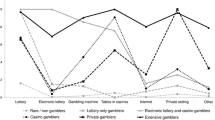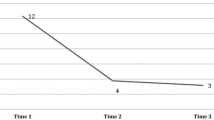Abstract
Segmentation of gamblers is useful for understanding their distinctive characteristics and enforcing customized measures in harm minimization work. Previous research has commonly adopted gambling motivation and involvement as segmentation criteria. However, these criteria are less identifiable through observation. Gambling forms, used in recent gambling segmentation research, are more observable, facilitating the prevention and treatment work of governments and practitioners, as the identified segments have distinctive gambling disorder symptoms. As gambling is widespread in the Chinese population and little is known about this ethnic group in terms of gambling form segments, latent class analysis was used to classify 855 Chinese gamblers in Macau based on their participation in 11 gambling forms in the previous 12 months. The analysis identified three distinct segments: casino gamblers, lottery gamblers, and sociable gamblers. Socio-demographic differences between the three segments were revealed. Casino gamblers, compared with their counterparts, were more likely to have DSM-V symptoms, particularly escape and bailouts. Lottery gamblers and sociable gamblers only differed in one symptom, the latter having a higher probability of chasing their losses. Based on these results, Macau policymakers are advised to prioritize their harm minimization measures such as requiring casinos to provide training to workers to help to identify gambling disorder symptoms and that workers should intervene when the symptoms of escape and bailouts were identified from the gamblers. Special attention should be given to Macau casino gamblers who are male, unemployed, or with highest education of high school diploma.

Similar content being viewed by others
References
American Gaming Association. (2018). Economic impact of the US gaming industry. Retrieved from https://www.americangaming.org/wp-content/uploads/2018/06/OE-AGA-Economic-Impact-US-2018-June.pdf. 28 March 2019.
American Psychiatric Association. (2013). Diagnostic and statistical manual of mental disorders: DSM-5 (5th ed.). Washington, DC: American Psychiatric Association.
Barsky, J. (2018). Fishing for whales: A segmentation model for social casinos. International Journal of Quality and Service Sciences,10(4), 400–421.
Boldero, J. M., Bell, R. C., & Moore, S. M. (2010). Do gambling activity patterns predict gambling problems? A latent class analysis of gambling forms among Australian youth. International Gambling Studies,10(2), 151–163.
Cantinotti, M., & Ladouceur, R. (2008). Harm reduction and electronic gambling machines: Does this pair make a happy couple or is divorce foreseen? Journal of Gambling Studies,24(1), 39–54.
Challét-Bouju, G., Hardouin, J. B., Lagadec, M., Burlacu, S., Valleur, M., Magalon, D., et al. (2016). Profiles of problem and non-problem gamblers, depending on their preferred gambling activity. Addiction Research & Theory,24(3), 209–222.
Challet-Bouju, G., Hardouin, J. B., Renard, N., Legauffre, C., Valleur, M., Magalon, D., et al. (2015). A gamblers clustering based on their favorite gambling activity. Journal of Gambling Studies,31(4), 1767–1788.
Chen, S. C., Shoemaker, S., & Zemke, D. M. V. (2013). Segmenting slot machine players: a factor-cluster analysis. International Journal of Contemporary Hospitality Management,25(1), 23–48.
Cotte, J. (1997). Chances, trances, and lots of slots: Gambling motives and consumption experiences. Journal of Leisure Research,29(4), 380–406.
Dowling, N. A., Smith, D., & Thomas, T. (2005). Electronic gaming machines: Are they the ‘crack-cocaine’ of gambling? Addiction,100(1), 33–45.
Ferris, J., & Wynne, H. (2001). The Canadian Problem Gambling Index: Final report. Ottowa: Canadian Centre on Substance Abuse.
Fong, L. H. N., Chui, P. M. W., Cheong, I. S. C., & Fong, D. K. C. (2018a). Moderating effects of social support on job stress and turnover intentions. Journal of Hospitality Marketing & Management,27(7), 795–810.
Fong, D. K. C., Fong, L. H. N., Chark, R., & Chui, P. M. W. (2018b). The bias of size in gambling decisions: Evidence from a casino game. Cornell Hospitality Quarterly,59(1), 78–84.
Fong, D. K. C., & Ozorio, B. (2005). Gambling participation and prevalence estimates of pathological gambling in a Far-east gambling city: Macao. UNLV Gaming Research & Review Journal,9(2), 15–28.
Gainsbury, S. M., Russell, A., Blaszczynski, A., & Hing, N. (2015). The interaction between gambling activities and modes of access: A comparison of Internet-only, land-based only, and mixed-mode gamblers. Addictive Behaviors,41, 34–40.
Geiser, C. (2013). Data analysis with Mplus. New York, NY: The Guildford Press.
Goudriaan, A. E., Slutske, W. S., Krull, J. L., & Sher, K. J. (2009). Longitudinal patterns of gambling activities and associated risk factors in college students. Addiction (Abingdon, England),104(7), 1219. https://doi.org/10.1111/j.1360-0443.2009.02573.x.
Griffiths, M., & Barnes, A. (2008). Internet gambling: An online empirical study among student gamblers. International Journal of Mental Health and Addiction,6(2), 194–204.
Hand, C., & Singh, J. (2014). Segmenting the betting market in England. International Journal of Market Research,56(1), 111–127.
Heiskanen, M., & Toikka, A. (2016). Clustering Finnish gambler profiles based on the money and time consumed in gambling activities. Journal of Gambling Studies,32(2), 363–377.
Lam, D. (2007). An exploratory study of gambling motivations and their impact on the purchase frequencies of various gambling products. Psychology & Marketing,24(9), 815–827.
LaPlante, D. A., Kleschinsky, J. H., LaBrie, R. A., Nelson, S. E., & Shaffer, H. J. (2009). Sitting at the virtual poker table: A prospective epidemiological study of actual Internet poker gambling behavior. Computers in Human Behavior,25(3), 711–717.
LaPlante, D. A., Nelson, S. E., LaBrie, R. A., & Shaffer, H. J. (2011). Disordered gambling, type of gambling and gambling involvement in the British Gambling Prevalence Survey 2007. The European Journal of Public Health,21(4), 532–537.
Lee, C. K., Lee, Y. K., Bernhard, B. J., & Yoon, Y. S. (2006). Segmenting casino gamblers by motivation: A cluster analysis of Korean gamblers. Tourism Management,27(5), 856–866.
Lesieur, H. R., & Blume, S. B. (1987). The south oaks gambling screen (SOGS): A new instrument for the identification of pathological gamblers. American Journal of Psychiatry,144(9), 1184–1188.
Macau Gaming Inspection and Coordination Bureau. (2017). Gaming statistics. Retrieved July 8, 2019 from http://www.dicj.gov.mo/web/en/information/DadosEstat/2016/content.html#n1.
Moufakkir, O., Singh, A. J., der Woud, A. M., & Holecek, D. (2004). Impact of light, medium and heavy spenders on casino destinations: Segmenting gaming visitors based on amount of non-gaming expenditures. UNLV Gaming Research & Review Journal,8(1), 59–71.
Muthén, L. K., & Muthén, B. O. (2015). Mplus user’s guide (7th ed.). Los Angeles, CA: Muthén & Muthén.
Nylund, K., Asparouhov, T., & Muthén, B. O. (2007). Deciding on the number of classes in latent class analysis and growth mixture modeling: A Monte Carlo simulation study. Structural Equation Modeling: A Multidisciplinary Journal,14(4), 535–569.
Park, M., Yang, X., Lee, B., Jang, H. C., & Stokowski, P. A. (2002). Segmenting casino gamblers by involvement profiles: A Colorado example. Tourism Management,23(1), 55–65.
Rennert, L., Denis, C., Peer, K., Lynch, K. G., Gelernter, J., & Kranzler, H. R. (2014). DSM-5 gambling disorder: Prevalence and characteristics in a substance use disorder sample. Experimental and Clinical Psychopharmacology,22(1), 50–56.
Ronzitti, S., Soldini, E., Lutri, V., Smith, N., Clerici, M., & Bowden-Jones, H. (2016). Types of gambling and levels of harm: A UK study to assess severity of presentation in a treatment-seeking population. Journal of Behavioral Addictions,5(3), 439–447.
Studer, J., Baggio, S., Mohler-Kuo, M., Simon, O., Daeppen, J. B., & Gmel, G. (2016). Latent Class Analysis of gambling activities in a sample of young Swiss men: Association with gambling problems, substance use outcomes, personality traits and coping strategies. Journal of Gambling Studies,32(2), 421–440.
Tang, C. S. K., & Wu, A. M. S. (2009). Screening for college problem gambling in Chinese societies: Psychometric properties of the Chinese version of the South Oaks Gambling Screen (C-SOGS). International Gambling Studies,9(3), 263–274.
Tang, C. S. K., Wu, A. M. S., Tang, J. Y. C., & Yan, E. C. W. (2010). Reliability, validity, and cut scores of the South Oaks Gambling Screen (SOGS) for Chinese. Journal of Gambling Studies,26(1), 145–158.
Walker, D. M., & Sobel, R. S. (2016). Social and economic impacts of gambling. Current Addiction Reports,3(3), 293–298.
Welte, J. W., Barnes, G. M., Wieczorek, W. F., Tidwell, M. C. O., & Hoffman, J. H. (2007). Type of gambling and availability as risk factors for problem gambling: A tobit regression analysis by age and gender. International Gambling Studies,7(2), 183–198.
Welte, J. W., Barnes, G., Wieczorek, W., Tidwell, M., & Parker, J. (2004). Risk factors for pathological gambling. Addictive Behaviors,29(2), 323–335.
Wong, I. A., Fong, H. I. V., & Liu, M. T. (2012). Understanding perceived casino service difference among casino players. International Journal of Contemporary Hospitality Management,24(5), 753–773.
Wu, A. M. S., Lai, M. H. C., & Tong, K. K. (2014). Gambling disorder: Estimated prevalence rates and risk factors in Macao. Psychology of Addictive Behaviors,28(4), 1190–1197.
Author information
Authors and Affiliations
Corresponding author
Ethics declarations
Conflict of interest
The authors declare that they have no conflict of interest.
Ethical Approval
This study was conducted on already available data and thus retrospective in nature. We were approved to use the data for publication purpose by the data owner.
Additional information
Publisher's Note
Springer Nature remains neutral with regard to jurisdictional claims in published maps and institutional affiliations.
Rights and permissions
About this article
Cite this article
Nong, S.Z., Fong, L.H.N., Fong, D.K.C. et al. Segmenting Chinese Gamblers Based on Gambling Forms: A Latent Class Analysis. J Gambl Stud 36, 141–159 (2020). https://doi.org/10.1007/s10899-019-09877-6
Published:
Issue Date:
DOI: https://doi.org/10.1007/s10899-019-09877-6




